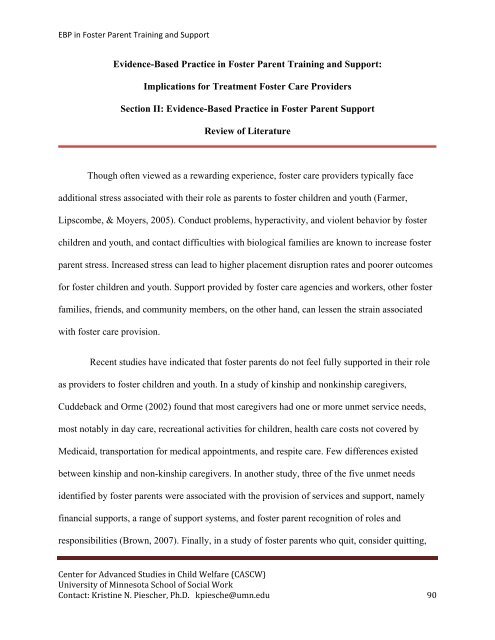EBP <strong>in</strong> <strong>Foster</strong> <strong>Parent</strong> Tra<strong>in</strong><strong>in</strong>g <strong>and</strong> <strong>Support</strong>Group vs. Individual Tra<strong>in</strong><strong>in</strong>gHampson, R. B., Schulte, M. A., & Ricks,C. C. (1983). Individual vs. group tra<strong>in</strong><strong>in</strong>gfor foster parents: Efficiency/effectivenessevaluations. Family Relations, 32, 191-201.Population: Family-based foster careweb) at the colleges, or if the colleges are the one’s responsible for the technologypiece/content, or just used for recruitment. <strong>Foster</strong> parents need <strong>in</strong>ternet access, <strong>and</strong>possibly access that supports large files (video, <strong>in</strong>teractive components).Method: Twenty-n<strong>in</strong>e foster parents received parent tra<strong>in</strong><strong>in</strong>g <strong>in</strong> child rear<strong>in</strong>g skills,utiliz<strong>in</strong>g a comb<strong>in</strong>ation of behavioral <strong>and</strong> reflective approaches. Half of the familieswere tra<strong>in</strong>ed <strong>in</strong> a traditional group tra<strong>in</strong><strong>in</strong>g format, while the other half was tra<strong>in</strong>ed<strong>in</strong>dividually <strong>in</strong> their homes. A total of 18 families received tra<strong>in</strong><strong>in</strong>g, 9 <strong>in</strong> centralizedgroups <strong>and</strong> 9 <strong>in</strong>dividually at home.Both modalities used two basic books: <strong>Parent</strong>s Are Teachers <strong>and</strong> Between <strong>Parent</strong> <strong>and</strong>Child. The tra<strong>in</strong><strong>in</strong>gs lasted for 11 weeks, The <strong>in</strong>-home tra<strong>in</strong><strong>in</strong>g sessions met weekly forone hour; group tra<strong>in</strong><strong>in</strong>g sessions met weekly for 1.5 hours. On average, the <strong>in</strong>-homeparents each received approximately 6.1 hours of tra<strong>in</strong><strong>in</strong>g, while each family received11 hours of tra<strong>in</strong><strong>in</strong>g. For the group tra<strong>in</strong>ed families, each parent received approximately6.2 hours of tra<strong>in</strong><strong>in</strong>g <strong>and</strong> each family received approximately 13.2 hours of tra<strong>in</strong><strong>in</strong>g, onaverage. Post-test<strong>in</strong>g was conducted dur<strong>in</strong>g the f<strong>in</strong>al week of tra<strong>in</strong><strong>in</strong>g. Follow-upquestionnaires were obta<strong>in</strong>ed six months after the conclusion of tra<strong>in</strong><strong>in</strong>g.F<strong>in</strong>d<strong>in</strong>gs: When the two groups were compared <strong>in</strong> terms of differential ga<strong>in</strong>s, relativelyfew differences were noted. As a general rule, group tra<strong>in</strong>ed parents demonstratedslightly greater <strong>in</strong>creases <strong>in</strong> parent attitude scores. Virtually all parents improved overthe course of tra<strong>in</strong><strong>in</strong>g, but parents with higher <strong>in</strong>itial levels of attitude <strong>and</strong> knowledgerema<strong>in</strong>ed <strong>in</strong> the higher rank orders follow<strong>in</strong>g the tra<strong>in</strong><strong>in</strong>g. The relative effect of group vs.<strong>in</strong>dividual tra<strong>in</strong><strong>in</strong>g was not significantly different. <strong>Parent</strong>s <strong>in</strong> the home tra<strong>in</strong>ed grouprated the overall improvements they perceived <strong>in</strong> their children’s behavior as greaterthan group tra<strong>in</strong>ed parents. There was a more durable pattern of satisfaction <strong>and</strong>perceived improvements for parents who were tra<strong>in</strong>ed <strong>in</strong> home.Limitations: No control group to compare with (i.e. no gra<strong>in</strong><strong>in</strong>g group or tra<strong>in</strong><strong>in</strong>g asusual, or those who didn’t volunteer). There may be differences <strong>in</strong> the group of<strong>in</strong>dividuals who volunteered which made them more prone to improvements. The smallsample size may have contributed to non-significant f<strong>in</strong>d<strong>in</strong>gs.Center for Advanced Studies <strong>in</strong> Child Welfare (CASCW)University of M<strong>in</strong>nesota School of Social WorkContact: Krist<strong>in</strong>e N. Piescher, Ph.D. kpiesche@umn.edu 89
EBP <strong>in</strong> <strong>Foster</strong> <strong>Parent</strong> Tra<strong>in</strong><strong>in</strong>g <strong>and</strong> <strong>Support</strong><strong>Evidence</strong>-<strong>Based</strong> <strong>Practice</strong> <strong>in</strong> <strong>Foster</strong> <strong>Parent</strong> Tra<strong>in</strong><strong>in</strong>g <strong>and</strong> <strong>Support</strong>:Implications for Treatment <strong>Foster</strong> Care ProvidersSection II: <strong>Evidence</strong>-<strong>Based</strong> <strong>Practice</strong> <strong>in</strong> <strong>Foster</strong> <strong>Parent</strong> <strong>Support</strong>Review of LiteratureThough often viewed as a reward<strong>in</strong>g experience, foster care providers typically faceadditional stress associated with their role as parents to foster children <strong>and</strong> youth (Farmer,Lipscombe, & Moyers, 2005). Conduct problems, hyperactivity, <strong>and</strong> violent behavior by fosterchildren <strong>and</strong> youth, <strong>and</strong> contact difficulties with biological families are known to <strong>in</strong>crease fosterparent stress. Increased stress can lead to higher placement disruption rates <strong>and</strong> poorer outcomesfor foster children <strong>and</strong> youth. <strong>Support</strong> provided by foster care agencies <strong>and</strong> workers, other fosterfamilies, friends, <strong>and</strong> community members, on the other h<strong>and</strong>, can lessen the stra<strong>in</strong> associatedwith foster care provision.Recent studies have <strong>in</strong>dicated that foster parents do not feel fully supported <strong>in</strong> their roleas providers to foster children <strong>and</strong> youth. In a study of k<strong>in</strong>ship <strong>and</strong> nonk<strong>in</strong>ship caregivers,Cuddeback <strong>and</strong> Orme (2002) found that most caregivers had one or more unmet service needs,most notably <strong>in</strong> day care, recreational activities for children, health care costs not covered byMedicaid, transportation for medical appo<strong>in</strong>tments, <strong>and</strong> respite care. Few differences existedbetween k<strong>in</strong>ship <strong>and</strong> non-k<strong>in</strong>ship caregivers. In another study, three of the five unmet needsidentified by foster parents were associated with the provision of services <strong>and</strong> support, namelyf<strong>in</strong>ancial supports, a range of support systems, <strong>and</strong> foster parent recognition of roles <strong>and</strong>responsibilities (Brown, 2007). F<strong>in</strong>ally, <strong>in</strong> a study of foster parents who quit, consider quitt<strong>in</strong>g,Center for Advanced Studies <strong>in</strong> Child Welfare (CASCW)University of M<strong>in</strong>nesota School of Social WorkContact: Krist<strong>in</strong>e N. Piescher, Ph.D. kpiesche@umn.edu 90
















